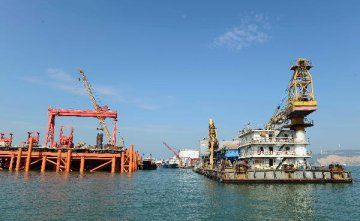
The flow orientation of foreign capital has seen new change in China.
In the first quarter, the growth of foreign capital attracted by the western region of China soared by 42.5 percent, much higher than 4.5 percent for the whole country, according to statistics from the Ministry of Commerce (MOC). At the meantime, hi-tech service industry also attracted a rapid inflow of foreign capital. Related experts indicated that investment in service industry will become a major direction to utilize the foreign capital, but the rapid growth of foreign direct investment (FDI) in Western China mainly benefits from relatively-low base quota.
FDI in Western China soared by 42.5 percent
The MOC spokesman Shen Danyang on April 19 stated in the press conference that China actually used the foreign capital of 224.21 billion yuan (equivalent to 35.42 billion U.S. dollars) in the first quarter, up by 4.5 percent year on year (excluding data in banks, securities and insurance fields). The actual amount used in Western China recorded 21.32 billion yuan (equivalent to3.33 billion U.S. dollars), up by 42.5 percent; and meanwhile, the FDI in Eastern China was 188.33 billion yuan (equivalent to 29.79 billion U.S. dollars), up by 2.8 percent; that of Middle China reached at 14.57 billion yuan (equivalent to 2.3 billion U.S. dollars), down by 11.3 percent.
“Utilization of the foreign capital is a highlight in the western region of China, and to some extent, it shows that Western China possesses a big potential to attract foreign capital.” Shen analyzed that the service industrial market in the western region has huge potential. Foreign investment in service industry of Western China grew rapidly in the first quarter, especially that the investment growth rates in the service industries, such as communications & transportation, wholesale & retail, information transmission and etc., were all over 100 percent; due to small base quota, the FDI was less than 15 billion yuan in the first quarter of last year; some large foreign-funded projects gained the capital one by one, for example, several large projects in Shaanxi Province and Chongqing successively obtained the foreign capital.
“Small base quota is a very important reason to greatly enhance those large projects. Additionally, along with increasingly-intensified national support for the Western China, foreign capital also gains expectation to some extent. Meanwhile, marginal effectiveness of investment in the eastern region also gradually weakens,” told Liang Ming, researcher at the MOC Research Institute.
It is worthy to pay attention to another trend that foreign capital inflow to the Hi-tech service industries is speeding up. In the first quarter, foreign capital actually used in these industries soared by 104.3 percent in the first quarter, partially, that of digital content industry and related services rocketed at 241.7 percent, with 208.2 percent in IT service.
In fact, the FDI of overall service industry in the first quarter accounted for 68.8 percent of the total amount nationwide, up by 7.6 percent. This proportion recorded 61.9 percent in the same period of last year; foreign capital actually utilized in China’s manufacturing industry declined by 1.6 percent in the first quarter, accounting for 30.4 percent of the total amount.
Referring to this, Liang believed that, along with construction of China’s four pilot free trade zones (FTZs) and wide popularization of negative list, the service industry will achieve more investment opportunities. “China is a powerful nation with huge trade deficits, formulation of the negative list and various opening measures makes the service industry more open, and investment in the service industry also becomes a major direction. Under the background of three destocks and one supplement, the manufacturing industry possibly enters into a flat period.”
In terms of annual trend to utilize the foreign capital, Shen indicated that it should have the capability to maintain the growth trend since the first quarter of this year.
Chinese capital outflow continues
Foreign capital is constantly inflowing, and while Chinese capital also continues to outflow.
Since this year, Chinese enterprises have explosively carried out overseas merging & acquisition: Dalian Wanda Group acquired an American company Legendary Pictures with 3.5 billion U.S. dollars; Foxconn Tech. Group gained the controlling right of Sharp Corporation with 3.5 billion U.S. dollars; and China Minsheng Investment Corp., Ltd. acquired an American company Sirius International Insurance Group with 2.5 billion U.S. dollars. Especially, China Three Corges Corporation acquired 30-year franchise right projects of Juvia and Ilia hydropower stations in Brazil with nearly 3.7 billion U.S. dollars, which was the largest merging & acquisition project based on overseas investment among Chinese enterprise in the first quarter.
The MOC data shows that Chinese enterprises totally conducted 142 such projects in the first quarter, with actual transaction capital of 16.56 billion U.S. dollars, and accounting for 41.3 percent of the total investment abroad in the corresponding period. This figure was 40.1 billion U.S. dollars for the whole year of last year, totally involving 593 overseas merging & acquisition projects implemented by Chinese enterprises.
These projects cover 15 industries in 36 countries or regions. Referring to industrial distribution, there are 27 projects involving in manufacturing industry, taking up 19 percent; 22 in information transmission, software and IT service, accounting for 15.5 percent; in terms of main subjects in merging & acquisition, those of local enterprises were 61.6 percent of the total amount.
“Overseas merging & acquisition have already become a significant way for Chinese enterprises to go out, and well participate in international labor division and cooperation, which play a key role in improving Chinese enterprises’ status in the global value chain, providing service for China’s economic transformation and upgrading, deepening mutual benefits and common development between China and the international community.” According to Shen, it is an inevitability of economic development, which can be achieved without effort.
Liang told the journalist that China is starting to transform towards a great power with trade and investment from a large trade nation. This trend indeed is spontaneously aroused by those enterprises, but in terms of targeted countries, it will enhance local employment and fiscal improvement. Referring to us, many overseas merging & acquisition and domestic industries will form a relationship in upstream and downstream industrial chain, pushing China’s products to go out.
Based on a group of data, Chinese enterprises’ investment abroad is still at a stage of preliminary development. The storage of China’s investment abroad only takes up 3.4 percent of the global amount, much lower than 24.4 percent of the U.S. and that of the UK, Germany, France, Japan and etc. The capital involved in Chinese overseas merging & acquisition only accounted for 6.2 percent of the global amount in 2015.
Translated by Jelly Yi






















Latest comments